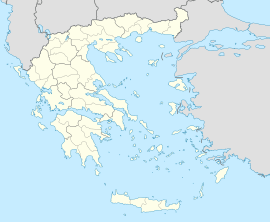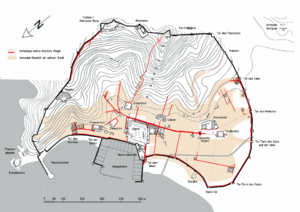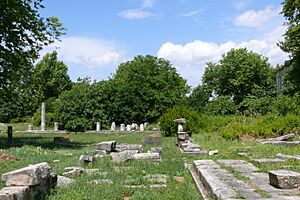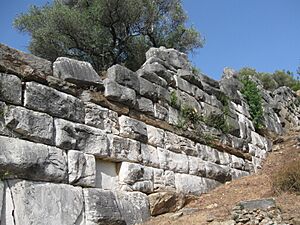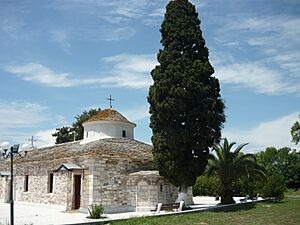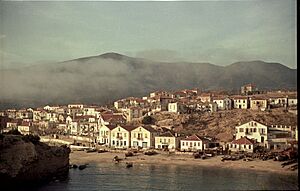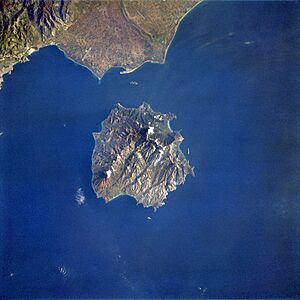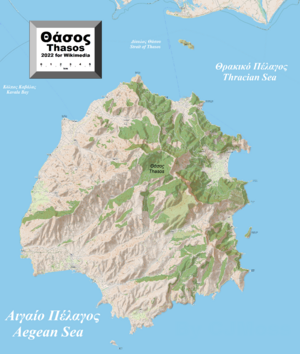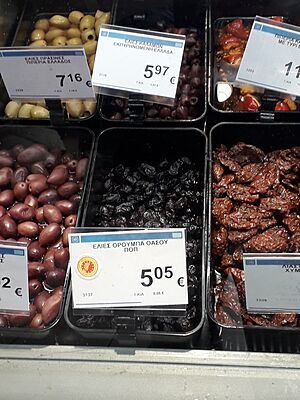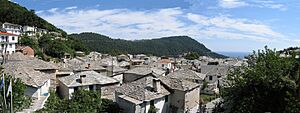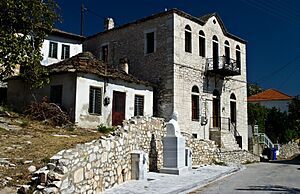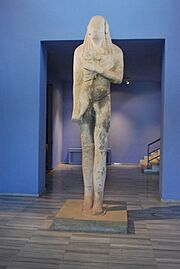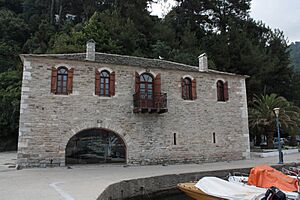Thasos facts for kids
Quick facts for kids
Thasos
Θάσος
|
|
|---|---|

Limenas (port) of Thasos, capital of the island
|
|
| Country | Greece |
| Administrative region | Eastern Macedonia and Thrace |
| Area | |
| • Total | 380 km2 (150 sq mi) |
| Elevation | 1,205 m (3,953 ft) |
| Population
(2021)
|
|
| • Total | 13,104 |
| • Density | 34.5/km2 (89.3/sq mi) |
| Time zone | UTC+2 (EET) |
| • Summer (DST) | UTC+3 (EEST) |
| Postal code |
640 04
|
| Area code(s) | 25930 |
| Vehicle registration | ΚΒ |
Thasos (also spelled Thassos) is a beautiful Greek island located in the North Aegean Sea. It is the northernmost large Greek island and the 12th biggest in terms of land area.
The island covers about 380 square kilometers (147 square miles) and has around 13,000 people living there. Thasos is its own special area called a regional unit within the East Macedonia and Thrace region. The biggest town and capital is also called Thasos. People often call it Limenas Thasou, which means "Port of Thasos". This main town is on the northern side of the island. You can reach Thasos from the mainland by taking a ferry from Keramoti to Thasos town, or from Kavala to Skala Prinou.
Tourism is the most important way people make money on the island. Farmers on Thasos grow honey, almonds, walnuts, olives (especially a special kind called Throumba), olive oil, and wine. People also fish and raise sheep and goats.
Contents
Island History: A Journey Through Time
Ancient Myths and Legends
Long ago, in Greek myths, a character named Staphylus lived on Thasos. He was said to be the beloved son of the god Dionysus, who was the god of wine and celebration.
Early Settlements: Life in Prehistory
Thasos is very old! People have lived here since the Palaeolithic period (the Old Stone Age). The earliest settlements studied in detail are at Limenaria. Here, things found from the Middle and Late Neolithic (New Stone Age) are similar to those on the mainland.
During the Early Bronze Age, Thasos was connected to the Aegean cultures, like those of the Cyclades islands. For example, at Skala Sotiros, a small village was protected by strong walls. Even older signs of human activity are large, human-shaped stone slabs built into these walls. These are quite unique for the Aegean area.
There's a gap in the history records until around 1100 BC, at the end of the Bronze Age. This is when the first burials happened at a large cemetery called Kastri, in the middle of the island. Here, people were buried in tombs covered with small mounds of earth. This style lasted until the end of the Iron Age. The oldest tombs had a few pots that looked like Mycenaean pottery. But most of the handmade pottery with carved designs showed connections to Thrace and areas further east.
Ancient Times: Phoenicians, Greeks, and Empires
The island was settled early by Phoenicians. They were likely drawn by the island's gold mines. They built a temple to their god Melqart. The Greeks later called this god "Tyrian Heracles." This temple was still there when the historian Herodotus visited. A leader named Thasos, said to be the son of Phoenix, led the Phoenicians and gave his name to the island.
Around 650 BC, Greeks from Paros started a colony on Thasos. A poet named Archilochus, who was a descendant of these settlers, wrote about a small war against a local tribe. Thasos became powerful and rich, partly because of its gold mines. They had mines on the mainland that were even more valuable than those on the island.
The capital city, also called Thasos, had two harbors. Besides gold, the island was known for its wine, nuts, and marble. Thasian wine was very famous. Old Thasian coins even showed images of the wine-god Dionysos and bunches of grapes.
During the Ionian revolt against Persia, Thasos was controlled by the Persians. After a city called Miletus was captured, an Ionian leader tried to attack Thasos but failed. The people of Thasos built warships and made their defenses stronger. But this made the Persian king Darius I of Persia suspicious. He forced them to give up their ships and tear down their walls.
After the defeat of Xerxes I, the Thasians joined the Delian League, a group of Greek city-states led by Athens. But they left the league because of a disagreement about their mines.
The Athenians eventually defeated Thasos' navy. They captured the capital after a two-year siege. The Thasians had to destroy their walls, give up their ships, and pay a regular fee. Later, in 411 BC, Thasos accepted a Spartan governor. But in 407 BC, the Spartans were kicked out, and the Athenians returned.
After a big battle called Battle of Aegospotami (405 BC), Thasos was again controlled by the Spartans. But the Athenians must have gotten it back. It became a point of disagreement between them and Philip II of Macedonia. Later, during conflicts between Philip V of Macedonia and the Romans, Thasos sided with Philip. But after the Battle of Cynoscephalae (197 BC), the Romans gave Thasos its freedom. It was still considered a "free" state even in the time of Pliny.
Archaeologists found an "Arch of Caracalla" and a statue of Empress Vibia Sabina, the wife of Emperor Hadrian, during excavations in 1887.
Middle Ages: Byzantine Rule and Changes
Thasos became part of the Eastern Roman Empire, also known as the Byzantine Empire, starting in 395 AD. The island was an important source of marble. This continued until the Slavic invasions in the late 500s and early 600s. Several old churches from this period have been found on the island.
Thasos remained under Byzantine control for most of the Middle Ages. In the 1200s, it was used as a naval base. For a short time (1307–1313), it was ruled by a Genoese leader named Tedisio Zaccaria. After returning to Byzantine control, its main church leader was given a higher rank. The Genoese Gattilusi family captured Thasos around 1434. They then gave it to the Ottoman Empire in 1455.
It is said that the Byzantine Greek Saint Joannicius the Great (752–846) once used his powers to free the island of Thasos from many snakes.
Ottoman Era: New Rulers and Revolts
Thasos became part of the Ottoman Empire in 1456. Under Ottoman rule, the island was known as Taşöz. Between 1770 and 1774, a Russian fleet briefly took over the island. By this time, most people lived in villages inland for safety.
Almost 50 years later, in 1821, a revolt against Ottoman rule began. This was at the start of the Greek War of Independence. Hatzigiorgis Metaxas led the revolt on Thasos, but it was not successful. An Ottoman count in 1831 showed that only Greeks lived on the island. It recorded 1,821 Greek men who were old enough to fight. The actual population was more than double this number.
In 1813, the Sultan Mahmud II gave the island to Muhammad Ali of Egypt as a personal gift. This was a reward for his help in a war. Thasos became a main place for recruiting Albanians to work in the Egyptian government until 1912. On October 20, 1912, during the First Balkan War, the Greek navy took over Thasos. The island then became part of Greece after more than 350 years of Ottoman Turkish rule.
Modern Era: Wars and Development
During World War II, from April 1941 to October 1944, Thasos was given by the Nazis to their Bulgarian allies. The Bulgarian government changed the island's name to "Tasos" and closed its schools. Thasos has many mountains, which helped people resist the occupation. This resistance was mainly led by a group called the National Liberation Front (EAM).
After the war ended and the Axis troops left in 1944, the island became part of the Greek Civil War. Skirmishes and attacks by communist fighters continued until 1950. This was almost a year after the fighting ended on the Greek mainland.
In the years after the war, a man from Thasos named Costas Tsimas became well-known. He was a friend of Prime Minister Andreas Papandreou. He was chosen to lead the National Intelligence Service. He was the first non-military person to hold that job.
Today, Thasos, the capital, is often called Limenas or "the port." It has a ferry connection to Keramoti, which is near Kavala International Airport. This is the shortest ferry trip to the island. Another port, Scala Prinos, is 20 kilometers (12 miles) south of Thasos town. It has a ferry connection to Kavala.
Island Administration
Thasos is its own regional unit within the East Macedonia and Thrace region. It is also the only municipality in this regional unit. In 2011, a government change created the regional unit of Thasos from part of the old Kavala Prefecture. The municipality of Thasos stayed the same. It includes a few small, uninhabited islands besides the main island. Its total area is about 380 square kilometers (147 square miles).
Island Geography
Thasos is in the northern Aegean Sea. It is about 7 kilometers (4 miles) from the mainland and 20 kilometers (12 miles) southeast of Kavala. The island is mostly round, without many deep bays or large peninsulas. It is mountainous but not extremely rough. The land rises slowly from the coast to the center. The highest point is Ypsario (Ipsario), which is 1,205 meters (3,953 feet) tall. Pine forests cover much of the island's eastern slopes.
In the past, people on the island mainly farmed and raised animals. They built their villages inland. Some of these villages were connected to harbors by stairways called "skalas." Over time, as tourism grew, people slowly moved to these villages along the coast. This is why there are often "paired villages," like Maries and Skala Maries. Maries is inland, and Skala Maries is on the coast.
Geology: The Island's Rocks and Resources
Thasos is mostly made of rocks like gneisses, schists, and marble. These rocks are part of the Rhodope massif. The marble layers can be up to 500 meters (1,640 feet) thick. They are separated from the rocks below by a transition zone about 300 meters (984 feet) thick.
The rocks on Thasos have changed over time due to heat and pressure. This process is called metamorphism. The island's structure has also been shaped by several periods of folding and faulting.
Between Thasos and the mainland is a basin called the Nestos-Prinos basin. This basin has oil and is filled with sediments from the Late Miocene and Pliocene periods. These sediments include layers of rock salt, anhydrite-dolomite, sandstones, and coal.
Mining History: Digging for Treasures
The earliest mining on Thasos dates back to around 13,000 BC. During the Stone Age, miners dug for a red-yellow clay called limonitic ochre. Mining for metals like lead and silver started around the 7th century BC with the Phoenicians. Later, in the 4th century, the Greeks and then the Romans continued mining. These mines were both open pits and underground tunnels. They mostly dug for lead and silver, but also found gold, copper, and iron. The Byzantines also quarried marble on the island.
In the early 1900s, mining companies dug for zinc and lead ores. They produced about 2 million tons of ore. A factory in Limenaria made zinc oxide. Iron ore was also mined a lot from 1954 to 1964, yielding about 3 million tons. Since 1964, new studies have found a deep zinc-lead deposit. However, the only mining happening on the island today is for marble.
Island Climate
Thasos has a hot-summer Mediterranean climate. This means it has mild winters and hot summers.
| Climate data for Thasos | |||||||||||||
|---|---|---|---|---|---|---|---|---|---|---|---|---|---|
| Month | Jan | Feb | Mar | Apr | May | Jun | Jul | Aug | Sep | Oct | Nov | Dec | Year |
| Record high °C (°F) | 19.8 (67.6) |
20.4 (68.7) |
23.6 (74.5) |
27.3 (81.1) |
30.9 (87.6) |
35.7 (96.3) |
37.2 (99.0) |
39.0 (102.2) |
36.1 (97.0) |
30.0 (86.0) |
25.3 (77.5) |
20.9 (69.6) |
39.0 (102.2) |
| Mean daily maximum °C (°F) | 10.5 (50.9) |
12.2 (54.0) |
14.3 (57.7) |
18.5 (65.3) |
23.7 (74.7) |
28.3 (82.9) |
31.2 (88.2) |
32.1 (89.8) |
27.1 (80.8) |
20.9 (69.6) |
16.6 (61.9) |
12.5 (54.5) |
20.7 (69.2) |
| Daily mean °C (°F) | 7.3 (45.1) |
8.8 (47.8) |
10.7 (51.3) |
14.2 (57.6) |
19.2 (66.6) |
23.7 (74.7) |
26.4 (79.5) |
27.3 (81.1) |
22.8 (73.0) |
17.2 (63.0) |
13.4 (56.1) |
9.5 (49.1) |
16.7 (62.1) |
| Mean daily minimum °C (°F) | 4.1 (39.4) |
5.3 (41.5) |
7.0 (44.6) |
9.9 (49.8) |
14.7 (58.5) |
19.1 (66.4) |
21.6 (70.9) |
22.4 (72.3) |
18.4 (65.1) |
13.4 (56.1) |
10.2 (50.4) |
6.4 (43.5) |
12.7 (54.9) |
| Record low °C (°F) | −4.8 (23.4) |
−3.8 (25.2) |
−2.6 (27.3) |
2.3 (36.1) |
8.9 (48.0) |
11.4 (52.5) |
16.3 (61.3) |
17.8 (64.0) |
9.3 (48.7) |
6.6 (43.9) |
1.2 (34.2) |
−3.3 (26.1) |
−4.8 (23.4) |
| Average rainfall mm (inches) | 112.3 (4.42) |
55.7 (2.19) |
74.1 (2.92) |
48.7 (1.92) |
41.2 (1.62) |
57.5 (2.26) |
17.5 (0.69) |
15.6 (0.61) |
30.0 (1.18) |
71.2 (2.80) |
128.5 (5.06) |
142.3 (5.60) |
794.6 (31.27) |
| Source 1: National Observatory of Athens Monthly Bulletins (Dec 2014 - Sep 2023) | |||||||||||||
| Source 2: Thasos N.O.A station and World Meteorological Organization | |||||||||||||
Island Economy
Tourism is by far the most important way people make money on Thasos. The main things grown on the island are honey, almonds, walnuts, olives (like the special local Throumba kind), olive oil, and wine. People also raise sheep and goats, and they go fishing.
Other industries include cutting timber and mining. Mining on Thasos involves lead, zinc, and marble. There's a large marble quarry in the Panagia area, on a mountain near the Thracian Sea. The old marble quarries in the south, near Alyki, are now abandoned. They were used for mining in ancient times.
Towns and Villages
Here are some of the towns and villages on Thasos with more than 100 people, according to the 2021 census:
- Kallirachi (417 people)
- Limenaria (2,351 people)
- Panagia (672 people)
- Potamia (1,274 people)
- Potos (788 people)
- Prinos (1,160 people)
- Rachoni (408 people)
- Skala Kallirachis (554 people)
- Skala Marion (367 people)
- Skala Rachoniou (219 people)
- Skala Sotiros (360 people)
- Thasos (Limenas Thasou) (3,331 people)
- Theologos (515 people)
Population Changes Over Time
| Year | Town | Municipality |
|---|---|---|
| 1981 | 2,312 | – |
| 1991 | 2,600 | – |
| 2001 | 3,140 | 13,765 |
| 2011 | 3,240 | 13,770 |
| 2021 | 3,331 | 13,104 |
Places to Visit on Thasos
Thasos has many interesting places to explore:
- The Archaeological Museum of Thasos and the old market (agora) in Thasos town.
- The Acropolis of Thasos and the ancient theater near Thasos town.
- The Polygnotos Vagis Municipal Museum in Potamia.
- The Folklore Museum of Limenaria.
- Archangel Michael's Monastery.
- Saint Panteleimon Monastery: This monastery was built in 1843. Local stories say that workers tried to build it in one spot, but their work was destroyed each night, and their tools went missing. They followed footprints and found their tools near a spring. So, they built the monastery there instead.
- Monastery of the Assumption.
- Kastro: This village's exact start date is unknown, but it likely began during the time of Frankish rule.
- Krambousa Isle: This small island is off the coast of Skala Potamia. It's covered in thick plants and has a special wild vegetable called "Krambi." A small church dedicated to Saint Daniel is at the top of the hill. People visit this church every year on the saint's day.
- Mount Ypsario (Ipsario), the highest peak at 1,203 meters (3,947 feet).
- The Artificial Lake in Maries.
Famous People from Thasos
- Archilochos (7th century BC), a warrior and poet.
- Aglaophon (6th–5th century BC), a painter and teacher.
- Hegemon of Thasos, a comedian who invented parody.
- Leodamas (4th century BC), a mathematician.
- Neseus of Thasos, a painter.
- Polygnotos Vagis (1892–1965), a sculptor born on Thasos who moved to the US.
- Polygnotus (mid-5th century BC), a famous painter.
- Stesimbrotos (c. 470 BC – c. 420 BC), a wise speaker.
- Theagenes of Thasos (480 BC), an Olympic boxer.
- Pankratiast (476 BC), an Olympic runner.
- Androsthenes of Thasos (4th century BC), an Admiral who served under Alexander the Great.
- Vassilis Vassilikos (born 1934), a poet and author. His novel "Z" was made into an Academy Award-winning film. He was born in Thasos.


